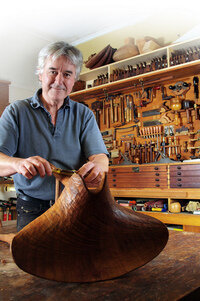Robert Howard
Tom Beattie
Growing up on a farm, I had ample opportunity to learn to use my hands to make things. Becoming an engineer (B Eng (Mech) UNSW 1971) seemed a logical way to extend this into a satisfying career.
However, the reality proved to be quite different, and it wasn’t until I accidentally discovered fine woodworking that found my true path. Here, I was free to dream, to design, and to make, using, as we like to say, my head, my heart and my hands. I must have been blessed, because I found this even though I did not know that it was what I was looking for.
More good fortune followed, when I was given the perfect opportunity to learn to make an extensive range of solid wood furniture, using traditional techniques, while being paid to do so.
Because the furniture I was learning to make reproduced antiques, I also had the opportunity to begin to learn decorative woodcarving.
By 1978 I was ready to strike out on my own. In those pre-internet days, finding customers was very difficult, and the method most craftspeople adopted to advertise their existence was to participate in exhibitions. Having made the decision to exhibit, I then had to decide what I wanted to exhibit, and, for reasons I cannot remember, I decided to carve some bowls.
This led to an invitation from Karen O’Clery, of Narek Galleries in Canberra, to show some bowls at SOFA (Sculpture, Objects and Functional Art Show) in Chicago. My bowls sold very well there, and have ended up in Collections at the Detroit Institute of Arts, Boston Museum of Fine Arts, Cincinnati Museum of Fine Arts, and the Figge Museum, as well as a number of private collections in the USA.
Most recently, here in Australia, one of my carved works won the $10,000 Wootha Prize for the best exhibit at the annual Maleny Wood Expo. I have been a regular contributor to the Australian Wood Review since June, 1996, and have been a Contributing Editor for many years.
The final string to my woodworking bow, and the one that has been my main source of income since about 1990, has been teaching private classes in fine woodworking and carving. This income has allowed me the room to explore my bowl carving, and to work without making compromises that I would not be comfortable with.
The recent popularity of spoon carving around the world is probably due to how well, as a creative activity, it fits the formats of the internet - in particular, You Tube and Instagram. It promises to expose a large number of people to the joys of using their hands creatively, and is an excellent introduction for woodworkers to working with three dimensional curves. For me, spoon carving completes a circle, because the very first things I ever carved, way back in 1980, were a spoon and a bowl.
As a woodworker who has managed to survive for 30 years, I have watched fine woodworking evolve from the fringe hobby of a dedicated few, into a substantial industry spread around the world. It has been a most enjoyable way to spend my working life.
